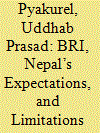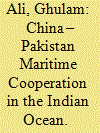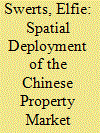| Srl | Item |
| 1 |
ID:
169360


|
|
|
|
|
| Summary/Abstract |
Many Nepalese perceive China’s Belt and Road Initiative (BRI) as a useful means for the India-locked country to connect to other countries. However, this paper analyzes the weakening connectivity within the border areas of Nepal and Tibet since falling under Chinese control, concluding that China is unready to increase cross-border movement and trade facilities with Nepal due to perceived security concerns.
|
|
|
|
|
|
|
|
|
|
|
|
|
|
|
|
| 2 |
ID:
169358


|
|
|
|
|
| Summary/Abstract |
The factors affecting the relationship between China and India can be divided into three categories: structural factors, hard factors, and soft factors. The structural factors are mainly geopolitical factors determined by national strength, geographical features and international status. Hard factors mainly include border conflicts, Tibetan issues, China–Pakistan relations and water disputes, which are difficult to solve and highly sensitive. Soft factors include a trade imbalance, visa issues, different notions of history, strategic differences, and the relationship between the two countries on the international stage. These three kinds of factors are differentiated. Their importance and influence on China–India relations are also changing. Geopolitical factors have begun to play more important role in the bilateral relationship of the two rising countries in the past few years, leading to their strategic competition. This competition has grown despite the fact that the two countries have not yet achieved a status as leaders of world politics. This premature strategic competition will hinder the development of the two countries and will make the “Asian century” hard to realize. For the security and interests of both nations and Asia as a whole, China and India must establish a more stable geopolitical relationship, promote bilateral cooperation in the field of hard and soft factors, and find opportunities for cooperation in new areas and spaces. Finally, China and India need to build a new type of power relations.
|
|
|
|
|
|
|
|
|
|
|
|
|
|
|
|
| 3 |
ID:
169359


|
|
|
|
|
| Summary/Abstract |
This paper argues that during the last two decades, China and Pakistan have strengthened their maritime cooperation in the Indian Ocean to their mutual benefit. Based upon its geostrategic location and vast maritime experience, Pakistan has promoted China’s growing interests in the Indian Ocean and received China’s economic, technological and military assistance in return. India has responded to these developments by expanding its naval power, adding a nuclear component and aligning with like-minded states. The paper concludes that a lack of institutional mechanisms, coordination and trust among the three can potentially expand their rivalry seawards, triggering a new naval arms race.
|
|
|
|
|
|
|
|
|
|
|
|
|
|
|
|
| 4 |
ID:
169357


|
|
|
|
|
| Summary/Abstract |
Real estate activities and companies in China have grown considerably since the major reforms of the late 1970s. This paper examines the spatial deployment of firms linked to the Chinese real estate market in Chinese cities in 2010, 2013 and 2016. It provides a first mapping of multinational firms specialized in the real estate sector. It describes the patterns of ownership networks built by financial links both between foreign multinational firms and Chinese firms and among multinational firms themselves. It therefore provides a new understanding about the penetration of both foreign direct investment (FDI) and Hong Kong’s role in the Chinese real estate market. This paper provides a comparison of the spatial location logics of these firms according to their Chinese or foreign origin and offers a new perspective on the geography of real estate investment by analyzing financial links between the Chinese and foreign cities involved.
|
|
|
|
|
|
|
|
|
|
|
|
|
|
|
|